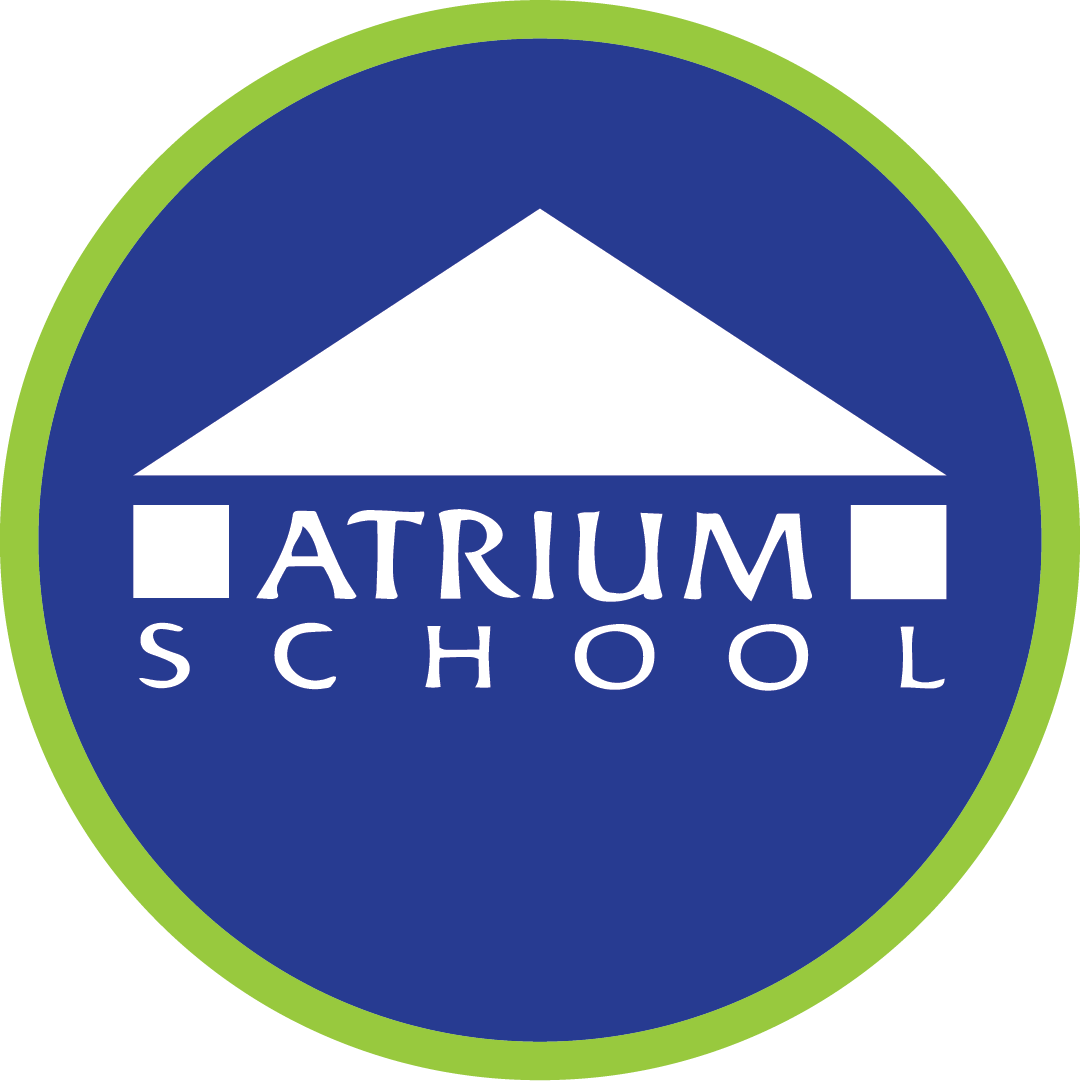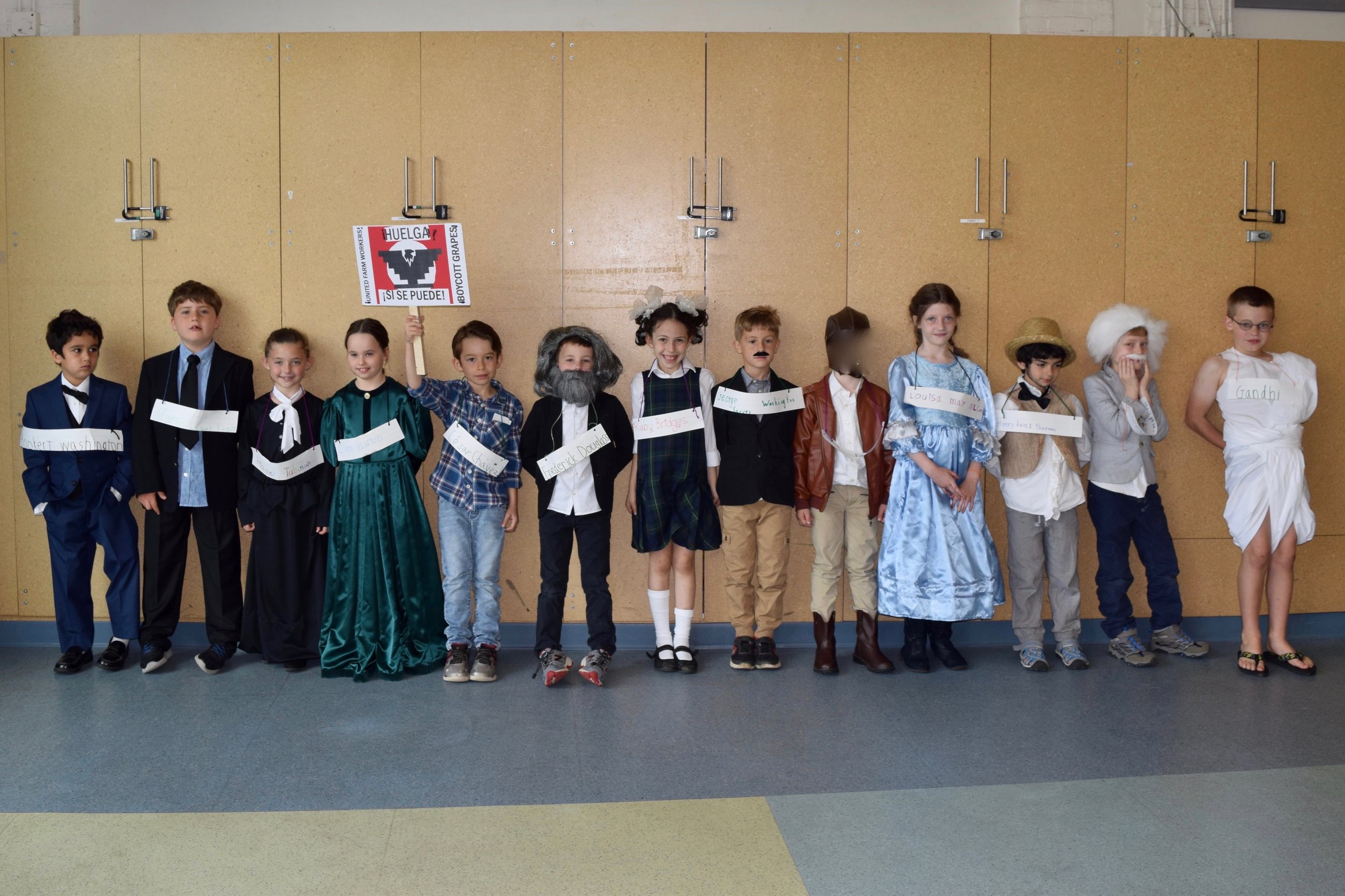Famous Social Justice Heroes Inspire Atrium
In recent weeks, Atrium has been visited by an impressive array of social justice heroes, including Frederick Douglass, Abraham Lincoln, Harriet Tubman, Clara Barton, Henry David Thoreau, Louisa May Alcott, Booker T. Washington, George Washington Carver, Mahatma Gandhi, Albert Einstein, Amelia Earhart, Cesar Chavez, Dr. Martin Luther King, Jr. and Ruby Bridges!
At the Hero Day assembly.
What made these extraordinary visits possible? For twenty years, students in Jill Ferraresso’s second grade class have been doing Heroism Studies: researching a hero from American history and then embodying them in a presentation before their class. While the project has transformed over the years, Heroism Studies are a hallmark of Atrium’s second grade curriculum; children learn how history is often driven by social justice visionaries.
Jill began the project 20 years ago to challenge a child at a reading level above her peers. Jill started her on a biography reading quest, and the student chose Clara Barton. She did a presentation for her class dressed as Clara and talked about her life. The class was captivated and a tradition was born. The project has changed over the years; now, the entire class participates and the subject matter connects to the history curriculum from the Underground Railroad to the Civil Rights Movement.
Jill and George Washington Carver.
Each spring, Jill assigns every child a hero and children spend the semester researching their hero’s life and contributions. Students read books and articles about their hero, seeking primary sources and learning to take notes as they collect the most accurate stories and facts they can find. For the presentation at the end of the year, students dress as their hero and emerge from a “time machine” in character.
In the early days of the project, children could choose any famous person they found interesting, until Jill realized that she wanted them to research individuals who had helped to shape the country. In addition, she discovered that it was difficult to find comprehensive information about many of the heroes on the original list. Ultimately, she created a list of about 25 heroes, all of whom are connected to at least one other hero on the list and to the history she teaches. Most of the heroes lived in America, but the exceptions influenced what happened in the United States.
“Connecting the heroes and embedding them in the history study creates a powerful learning community for the whole class, giving us a shared story,” Jill explained. “It is thrilling for Sojourner Truth to have the chance to talk to Abraham Lincoln and for Rosa Parks and Dr. King to have conversations. It is also amazing to hear the conversations these heroes have across time periods. When we have our hero day after all the presentations, all the children dress up again, reviving their heroes and pretending that we have all met in a common time.”
Jill and Henry David Thoreau.
As time passed, Jill’s history study became a celebration of black history in the United States, and an explanation of the racism that continues in America. Jill explained that students learn about enslavement and the Underground Railroad, discussing the horrors of enslavement and the resilience, braveness and cleverness of cleverness of slaves who escaped or helped others escape via the secret codes and hiding places of the Underground Railroad.
“When we study the Civil Rights Movement, children think about marches they have been a part of, such as marches for peace or against gun violence," Jill said. "Children ask more questions about groups like Black Lives Matter and they come to realize that racism is not over, and that the fight for equality is always in the hands of the young. Most of us will never be famous, just as most people who fought for equality during the Civil Rights Movement did not become famous. Not all heroes are famous people. Every day ordinary people demonstrate extraordinary courage in the face of incredible obstacles.”
Harriet Tubman.
In the first half of the year, second graders study what it means to be human. “Everything we learn is connected,” Jill said. “In the first semester in school, I teach children things that all human beings have in common. Children are outraged to compare our long list of human traits to the idea of bondage. If we all have feelings, smarts, and hopes and dreams, how could we do this to fellow human beings? If we all need love, acceptance, friendship and opportunities, how could we deny these things to one another?”
As they study heroes, children keep in mind that all humans are flawed–even heroes–and anyone can make a bad decision. They also learn that anyone can be a hero, regardless of their background. “Every child takes something different out of these studies. Many are amazed that ordinary people can do extraordinary things in the face of incredible obstacles. They realize that they too, have the capacity to lead their lives in a way that spreads love. They can be an ally for other people, and they can speak up if something is wrong. They can march, protest and vote. As Gandhi said, ‘We must be the change we want to see in the world.’”
The culmination of the children’s hard work is their hero presentation, during which students talk to their classmates for about 30 minutes about their hero. Each student writes questions for their classmates to ask about their hero, and Jill also prompts each hero to add information that might not be covered in the questions, or interesting anecdotes that help the class to better understand the hero. In the end, each student is so well prepared that he or she completely embodies their hero.
“Today Cesar Chavez presented,” Jill said. “His presentation lasted 40 minutes. His presentation told the story of his life. He infused it with his native language, speaking Spanish for some questions and then translating for us. He jumped up to passionately tell us his campaign rallying cry, ‘Si Se Puede!’ He told us incredible details about the hard lives of farm workers, the filthy conditions in which they worked, and let us know that the farm workers want what every human being wants, freedom and the chance to make a life for themselves and their families. The child doing this presentation never broke from his character, because he and Mr. Chavez had blended. I know he will never forget this day, or what Cesar Chavez has meant to him.”
Cesar Chavez.
Even after the thrill of the hero presentations has ended, students treasure this project for many years. Jill explained, “I hope the children will always have their hero’s wisdom to draw on, and their hero’s example as a guide. I know that many children write about this project in their college essays. One child told me that he brought his Frederick Douglass poster to his college dorm room to remind himself of the value of learning, and the privilege of getting an education, even when it’s hard. Maybe one of the children I teach will go on to do great things for others. I hope they will all leave second grade caring about other human beings and striving for fairness and equality. No matter what happens, each of the children I teach touches my life and gives me great hope for our collective future."





